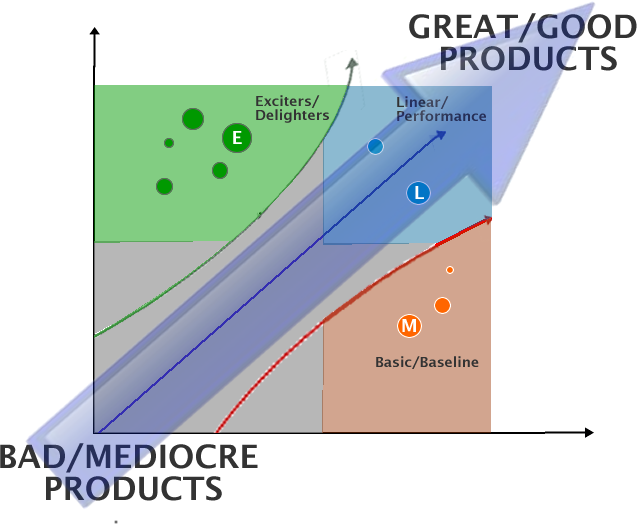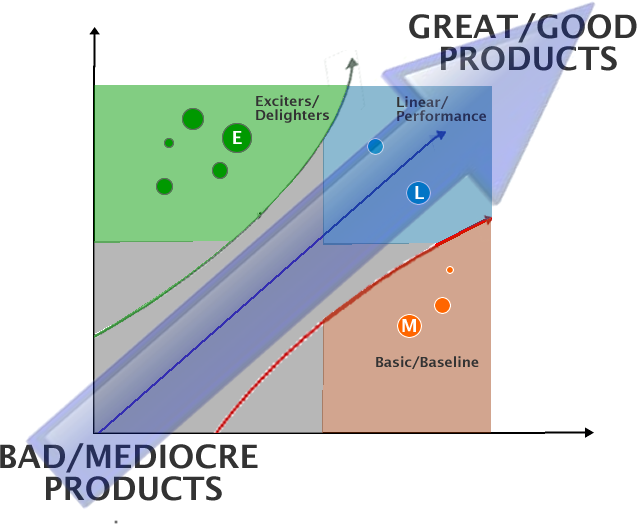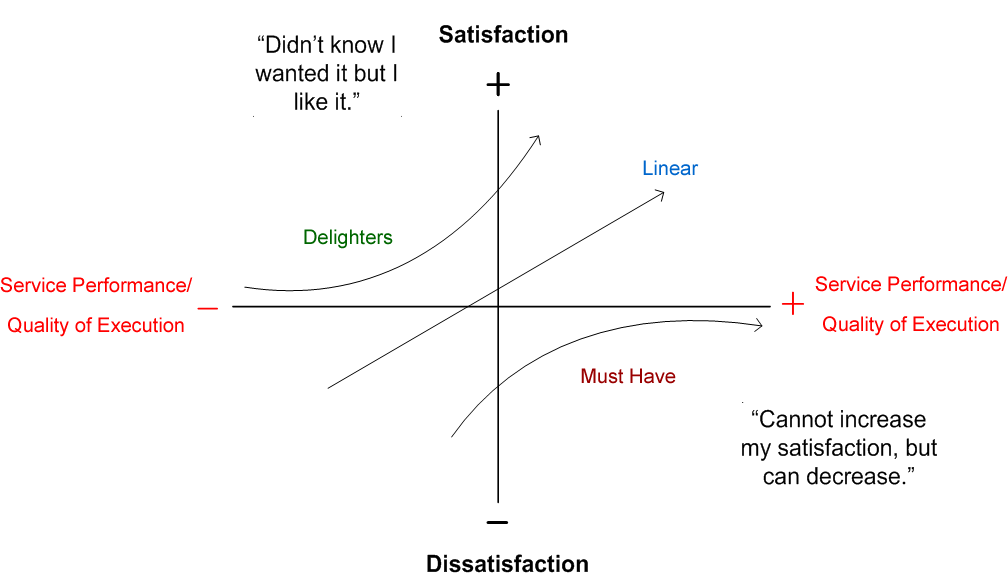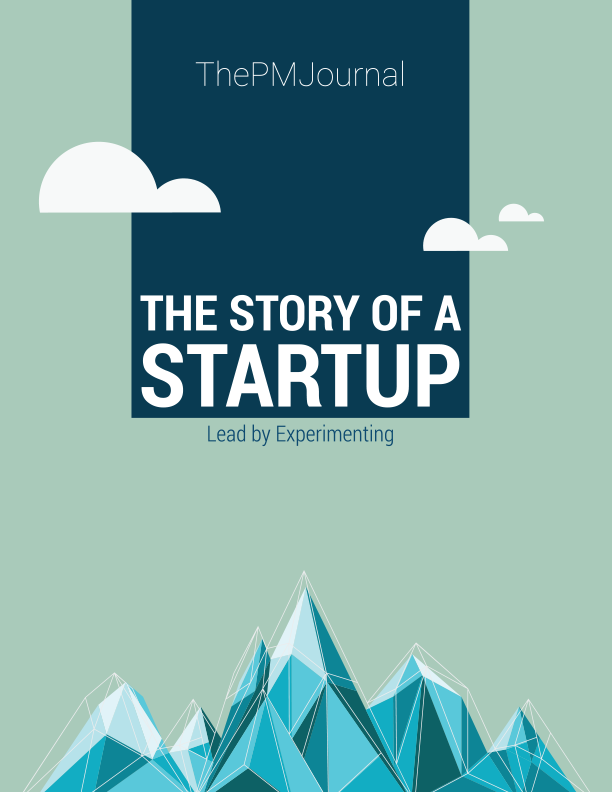Kano Model
Posted on May 12, 2013 by ThePMJournal
Kano Model helps mainly to prioritise product features based on customer preferences. Kano could be applied also to select marketing strategy based on market trends.

Kano is a survey realized with a relatively a small group of people (max. 20-30). In essence for each feature to be analyzed, are asked 2 questions:
- a functional question: How do you feel if the feature is present?
- a dysfunctional question: How do you feel if feature is absent?
We can observe, the accent of the question is on verb “to feel” and depends on an emotional response from people. The possible answers can be only one of five answers: Like (I like the way it is), Expect (I expect to be that way), Neutral (I don’t know), Live with (I can live with it that way), Dislike (I dislike in that way).
Those 2 answers, at the 2 questions (functional and dysfunctional), form a matrix o feature categories:
According with matrix above, each feature is one of the following category: type E-Exciter (Delighter), L-Linear (Performance), M-Mandatory (MUST to exist), I-Indifferent (if people are indifferent, you better skip his implementation), Q-Questionable (feature probably needs clarifications or explanation), R-Reverse (you better drop it, because might have an opposite effect than you expected).
How Kano is interpreted?
The 6 categories (M, E, L, R, Q, I) from Kano Matrix can be represented in the following graphic:
X-axis represents the answer to dysfunctional question, and Y-axis represents the answer to functional question (the graphic is a personal interpretation of Kano Model). Zones of interests are blue, green and red. Features found anywhere else, outside colored zones, most probably won’t make to many customers happy… As can be seen, the customers happiness increases when we have E-Exciter or Linear-L type features (colored zones).
Exercise
Suppose we have 3 features and we want to know what impact have on customer satisfaction if deserves to invest time and money to implement. Eventually if we know in what order to implement (to prioritize) them would be wonderful.
Lets say the features are: a mobile application to enjoy during our free time, a configuration module help us planning our lives better, a teleportation module help us travelling instantly on other planets.
24 people reply at functional and dysfunctional questions:
Accoring to results, the majority considers “teleportation” a E-Exciter type feature. “Mobile Native App” is L-Linear/Performance (even is a whim, it can increase significantly customer satisfaction) and “Configuration Module” is a M-MUST type feature.
The theory behind the Kano Model says the implementation always begins with “M” features. Normally they are followed by “L-Linear” and then E-Exciters (Exciters are the lowest priority). The rest I, Q, R should not be implemented at all or requires re-evaluation for more safety. However in real life, if we always implemented in this order:M, L, E, then E- type feature might never be implemented as they are the last ones. Without E features, the entire product management can go to hell, because no one would create revolutionary products. In practice, it is used the products to contain M-type features, L type features, but also innovative E-type features. The measure of which the producers combine those ingredients is their professional secrets and represents the border between failure and success.
Relation between Kano Model and Good Products
My personal opinion is a product should be perfectly balanced and need to contain an equal quantity of elements: M, E, L, but, just for safety reasons, type L-Linear elements are those should take first care. I will explain later why L-Linear type elements need special attention.
The good/exceptional products begin when basic features (M features) are combined with L features. The exceptional products are in the blue zone (to the right, the quality of the features is increased). The more quality for L-type features, the better product is. If you have a product with multiple type features (E, L, M), is always good to have a median dispersion of features in blue zone. You can obtain a median dispersion in blue area if you have a a balance between number of E and M features or if you have a majority of L-Linear features (this is the reason why L-Linear type features are so important).
Quality of Execution
In original Kano model, X-axis is represented by quality of execution/service offered. Kano Model, adding quality of execution in equation looks like:
Until now, we supposed Kano model, features are perfectly implemented, with a high quality. What happens if, despite a feature is E-type feature is really innovating, the implementation and the quality is low? If quality is low, then the feature could be crappy, no matter how innovative was the idea. It is logical: the theory says, E-type features can increase customer satisfaction exponentially depending on execution’s quality. That’s why, pay attention to quality! It is not enough to have a good idea, but you need also an exceptional quality of implementation. Features L-Linear there are the most affected features by the quality of execution (that’s why I underline the importance of L-Linear features).
Note that type M-features (Must Have/Mandatory) increases customer satisfaction until a certain level, then no matter the quality of execution is, the happiness of the customers remain the same (a “plateau” is achieved, similar to neurons and muscle fibers, if the stimulus exceeds the threshold potential, the response/result is the same). Also remark type M-feature bring in the best case a moderate customer satisfaction (no matter how quality has); M-Mandatory features bring mediocrity: with the high quality M-features, customers are not too happy, not too upset.
How important are E-Exciter elements?
E-type elements represents either a new innovative feature/product, either a genius marketing strategy. To a Startup, E-Exciters elements could be the “vital” features. Why are so vital? For example, one of the reasons the F-Startup failed, was we didn’t pay enough attention to E-type features (we didn’t allocate enough resources and time to make a high quality for the innovative features). Another example, are startups creating products without any innovative features (E-Exciters), which in the actual context of a market place “hungry for innovation”, are like small fishes in the big ocean who, sooner or later, will be eaten by a bigger fish. In other words, a start-up doesn’t innovate, do not survive. A second rule related to statups and E-features is: the quality of the execution of E-type features should be “state-of-art”. Would be shame if a startup, with a good idea of products, but with a bad implementation, fails because the released product did not meet the quality standards they wanted (the quality, by definition, represents the degree which project/product match the initial requirements and acceptance criteria). Practically someone did not put enough effort to implement a high quality for his revolutionary product, deserves the prize of “The Human Stupidity” for the “best product bankrupt by human idiocy”.
E-Exciters (see the green zone below) play a major role in “Crossing the Chasm” theory (see the below image). For a startup to jump over the “chasm” between non-existence and existence, it is necessary a “critical” number of “excited” consumers (early adopters of E-elements). Majority of startups are stooped, from their evolution, just before the jump over the chasm, because either their products are missing E-Exciters features, either because their products don’t have a critical number of E-Exciters elements or because the quality of E-Exciters elements was low and did not make happy a critical mass of customers.
Kano Pro and Cons
Kano Model has a series of interesting interpretations, but requires effort to collect data from various stakeholders. The survey does not take more than one hour per customer, but you need at least a pool of 20 people and the process could last days. Besides the survey time, you need to consider also time spent to centralize and analyze the information. For a large product, let’s say it is time well spent, but on a small product it is highly unlikely you won’t have the luxury to spent time on Kano analysis. After you finish the nice graphics and analysis, your product might be cataloged as “bad” product, but Kano model won’t say you why? Could be a bad product because customers did not take too seriously your survey or might be because the features you surveyed were not well understood, etc. In other words, Kano Model can’t say you why your product is considered “bad” or what should you change to make it better, but can offer you a guide to build better products in the future. Here are several lessons you could learn from Kano:
- be moderate in whatever you do (do not overestimate “E-exciter” features, do not underestimate M-Mandatory features)
- have a balance number of L-Linear, M-Mandatory and E-Exciters features.
- whatever you do outside this areas (Exciters, Mandatory, Linear) could be “bad”.
Based on Kano analysis, a product could to be consider a potential “bad”, if majority of features are “Questionable”, “Reverse” or “Indifferent”, but still could be a revolutionary product. How is that possible? Kano Model is based on an emotional (biased) response. An emotional response is not always reliable, because people don’t always know what they want (Steve Jobs once said “It’s really hard to design products by focus groups. A lot of times, people don’t know what they want until you show it to them.“). Here Kano shows its limitations.
Maybe the model can help us take a better decision when you have your product in “Exciters, Linear or Mandatory” areas, but you can’t take any decision when your features are: “Questionable, Reversible, Indifferent”. Let’s consider a extreme scenario: How middle eve man would react in front of an iPhone? probable would say: “I dislike it, it’s the devil’s work!”, but after few centuries the same man would say: “I like it. Thank you Steve!“. So here we have the answer of the medieval and contemporary man, according to Kano Model, an iPhone is a “Q-Questionable” product (it is like you ask: Should have invented the iPhone?)
Conclusion
Kano Model offer a prioritization method of features depending on level of customer satisfaction. Despite the model offer a pertinent interpretation of features only on emotional responses, consumers wishes and sometimes “illogical” choices of stakeholders, it predicts very well the behavior of consumers on real market. The Model is interesting and useful, because offers a logical interpretation of illogical choices.
Recommendation: Priorities, a logical choice!















Be the first to leave a comment